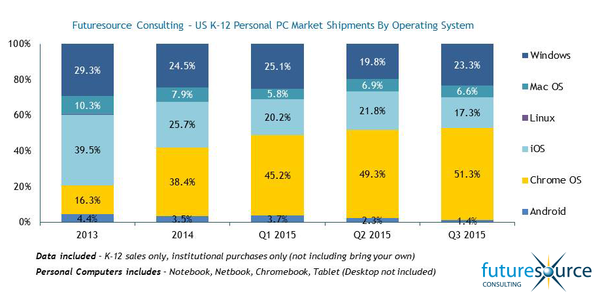Chromebooks Thriving in U.S. K-12, but Is Microsoft Poised for Global Growth?
A new analysis of the school market for digital devices and operating systems finds that demand for Google Chromebooks is continuing to climb in the United States, as district officials are drawn to those products’ low cost and simplicity of use.
But a different story could emerge in the market beyond U.S. borders in 2016, one that’s more favorable to rival Microsoft, argues Futuresource Consulting, in its examination of trends in the K-12 industry.
The market analysis released this week by Futuresource, on the one hand, reinforces a story that’s been emerging for the past few years, about Chromebooks’ growing popularity in U.S. K-12 classrooms.
In the third quarter of 2015, Chromebooks topped 50 percent of the market for the first time in the United States—reaching 51 percent—with 1.63 million units sold, according to Futuresource’s EdTech K-12 Market Report. See a breakdown, below:
Districts have been impressed with a host of Chromebook features, including their low cost, their relative simplicity, and easy management for different users, notes Futuresource, a U.K.-based research and consulting company. See Education Week’s recent reporting on the allure of Chromebooks among U.S. administrators and educators.
The picture, however, looks different outside the U.S. market, and potentially much more favorable to Microsoft, Futuresource contends. The Redmond, Wash.-based company’s devices for schools are maturing, and prices are likely to fall—both of which are probably going to help the tech giant prosper in the global school market, the consultants predict.
Chromebooks have only about 3 percent of the school market share outside the U.S. today, Futuresource Consulting estimates. One reason for the lack of traction: Many foreign countries by and large aren’t facing the immediate pressure to move to online assessments, a high-stakes testing wave that has fueled interest in Chromebooks in the United States. (See the graphic at the top of this entry for Futuresource’s breakdown of Chromebooks’ share of the market, by country.)
In addition, many developing countries lack the kind of reliable Web connectivity necessary to make Chromebooks’ cloud-based systems work smoothly, the report says.
By contrast, Futuresource argues that Microsoft is well-positioned to grow in the school market outside the United States. Heading into 2016, a number of factors could bolster Microsoft in global K-12, argues Futuresource:
- Microsoft’s recently announced partnership with Lightspeed Systems could help the huge tech provider revamp the manageability of its devices for different K-12 users. Currently, Chromebooks’ simplicity of use has been a selling point among K-12 officials, above what Microsoft was offering, Futuresource notes.
- The market for “2-in-1” products (devices that can be used as tablets, or as notebooks with detachable keyboards) is poised to grow, as prices for those devices fall. Microsoft has traditionally fared well in the 2-in-1 market, says Futuresource, and as prices of those devices drop, they will gain popularity in emerging nations.
“In general it is a good story for end users,” said Mike Fisher, associate director of education technology for Futuresource Consulting, in an e-mail to Education Week. “Overall growth in the education PC market (compared to sluggish developments in the total market) is resulting in PC vendors and OS providers fighting hard to develop their offerings.”
Those battles ultimately result in a more diverse array of products, and lower prices, Fisher added.
Whether Futuresource’s prediction of international prowess for Microsoft takes hold remains to be seen. But there’s clearly a burgeoning interest in many developing countries bringing new tech tools and platforms to their primary and secondary education systems, as their economies improve, and students’ and families’ use of devices and tools takes hold.
And U.S.-based education companies—from behemoths like Microsoft to relatively new players on the scene, many of them selling software, games, apps, management systems, and other products—are eager to claim their stake to those new territories.
See also:
- Global Market for Ed-Tech Hardware Grows
- Chromebooks Command Half of K-12 Computing Market, Analyst Says
- Chromebooks Gaining Popularity in School Districts
- Schoology Wins Contract for Ambitious Ed-Tech Product in Uruguay
- Consumer Games for Digital Learning Games, Simulations Grows Worldwide
- Knewton Launches Partnerships With Ed. Companies in China, Japan



One thought on “Chromebooks Thriving in U.S. K-12, but Is Microsoft Poised for Global Growth?”